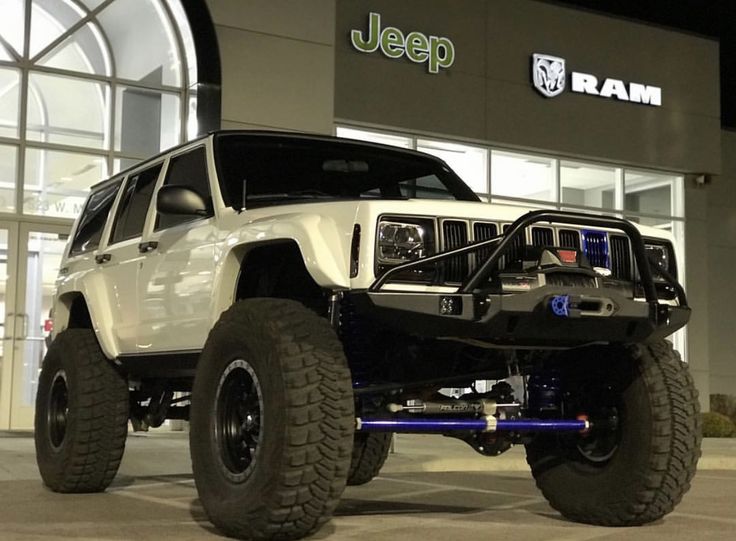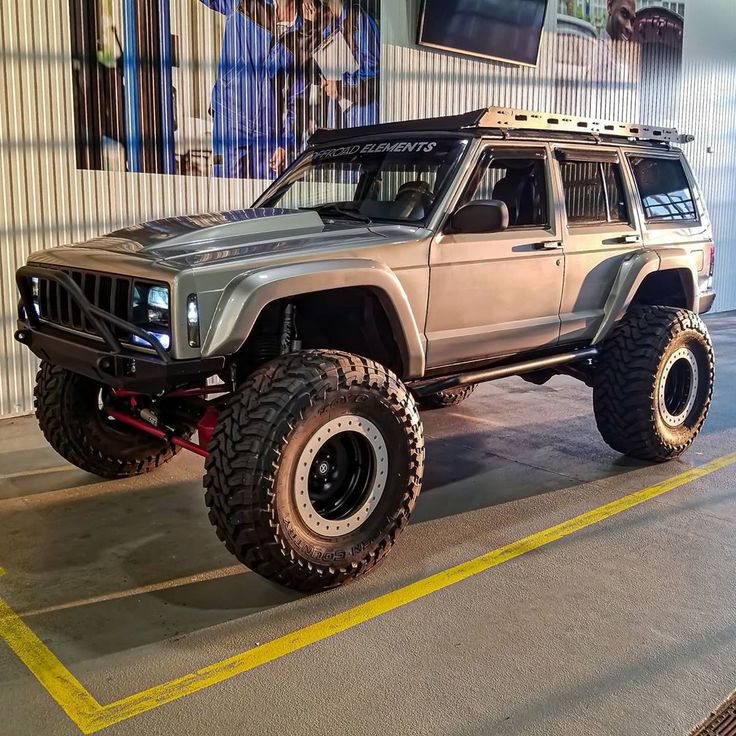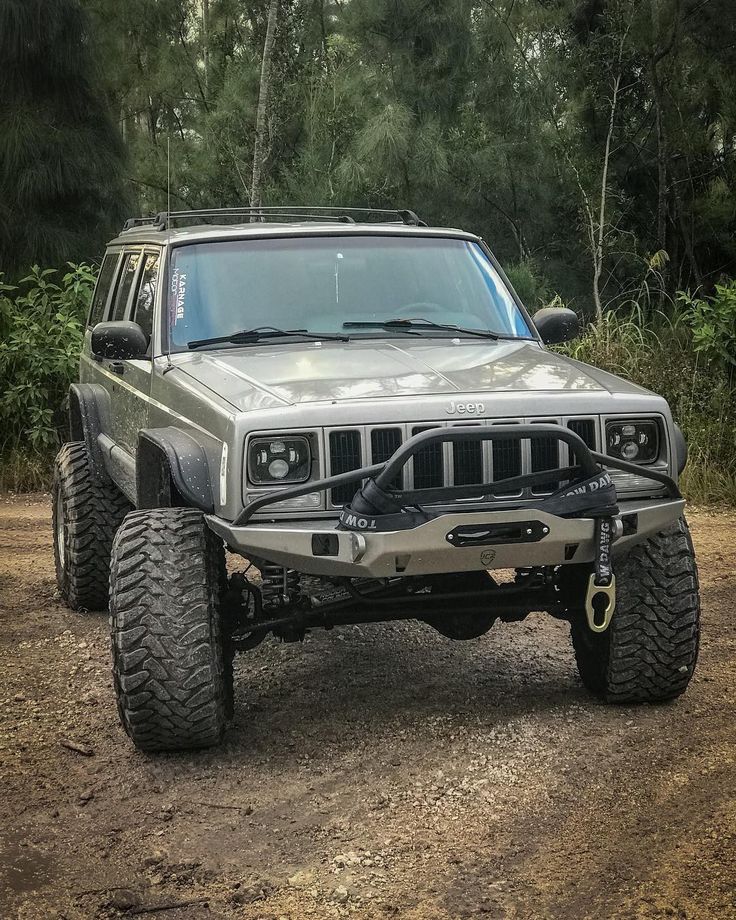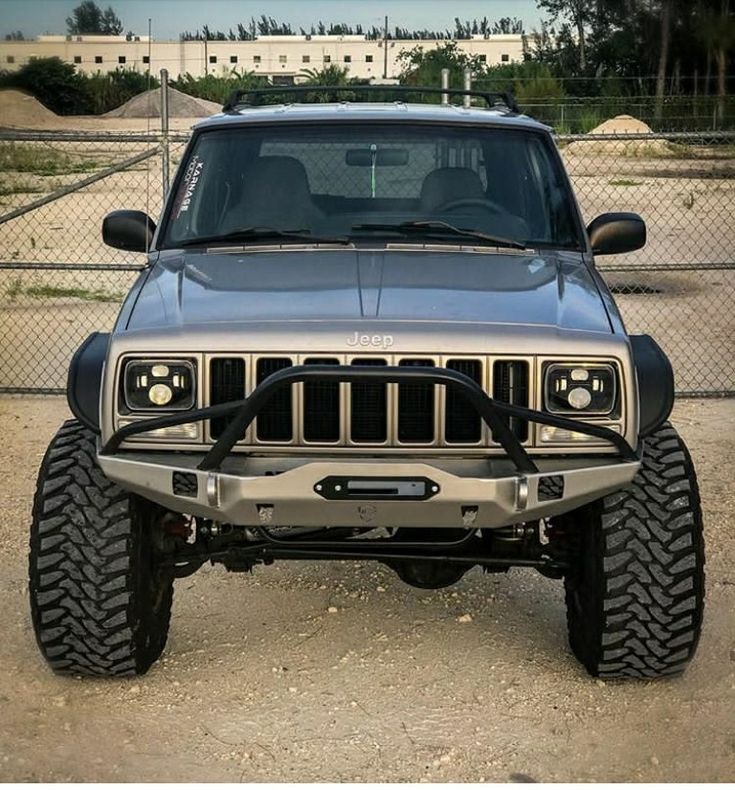If you own a Jeep Cherokee XJ, you know it’s not just a vehicle—it’s a lifestyle. Lifting your XJ is one of the best ways to enhance its off-road capabilities and make it stand out. But with so many lift kits available, choosing the right one can be overwhelming. This guide explores the top five Jeep XJ lift kits for every budget, detailing their components, installation time, difficulty, tools needed, and price. Everything you need to find the best jeep xj lift kit for you!
What is the best Jeep XJ lift kit?
Choosing the best lift kit for your Jeep Cherokee XJ depends on how you plan to use it. Whether for daily driving, mild trails, or hardcore off-roading, the right combination of lift height, suspension upgrades, and axle components will vary.
Lift Heights and Their Uses
- 2-3 Inches of Lift: Ideal for daily driving and light off-road trails. This height allows for 31-inch tires and often requires minimal modifications to the suspension or axles.
- 3.5-4.5 Inches of Lift: Perfect for moderate off-roading. It accommodates 32-33 inch tires and often includes upgraded components like adjustable control arms and track bars for better handling.
- 5 Inches or More: Designed for extreme off-road use. It supports 35-inch tires or larger and typically requires significant upgrades to the drivetrain and axles.
Suspension Components
- Front Suspension: Lift kits often include new coil springs, adjustable control arms, sway bar disconnects, and a track bar to maintain alignment and stability.
- Rear Suspension: Rear leaf springs or add-a-leaf kits are commonly included, along with extended shackles or blocks to match the front lift.
Axle Considerations
- Front Axle: The Dana 30 is standard on most XJs. Reinforcements or upgraded shafts may be needed for lifts exceeding 4 inches.
- Rear Axle: The Dana 35 or Chrysler 8.25 may require upgrades like stronger axles or gear changes to handle larger tires and increased stress.
When selecting the best Jeep XJ lift kit for you, consider reputable brands like Rubicon Express, Clayton Off Road, and Rough Country. Match the kit to your needs and ensure all components—suspension, axles, and drivetrain—are compatible with your desired setup.
Suspension Geometry: Why It Matters for Your Jeep XJ
When you lift your Jeep Cherokee XJ, you’re not just raising its height—you’re also changing its suspension geometry. This means altering the angles and relationships between key suspension components like control arms, track bars, and axles. Think of it like wearing platform shoes: yes, you’re taller, but your balance and stride feel completely different.
Lifting an XJ affects how the suspension moves, how the tires grip the road, and even how the brakes perform. While it might look awesome and improve off-road capability, ignoring the effects of these changes can lead to quirky, unpredictable, or even unsafe driving behavior.
Suspension geometry refers to the angles and alignment of suspension components, including control arms, track bars, steering links, and axles. Maintaining proper geometry is like keeping your car’s skeleton in perfect shape—if things are out of place, the whole system struggles to work correctly.
Why Suspension Geometry is Important
The geometry of your suspension ensures that your tires stay firmly planted on the ground, whether you’re cruising the highway or crawling over rocks. It’s like keeping your feet under you when walking on ice—get it wrong, and you’ll be slipping all over the place.
What Happens When You Modify Suspension Geometry
- Caster Angle Changes
- Technical Talk: A lift reduces the caster angle, which can result in wandering or instability at highway speeds.
- In Simple Terms: Imagine a shopping cart wheel that swivels wildly at high speeds—it’s kind of like that but scarier, because you’re not buying groceries, you’re driving a Jeep at 70 mph.
- Driveshaft Angles
- Technical Talk: Improper angles in the driveshaft can cause vibrations and put stress on U-joints.
- In Simple Terms: It’s like playing with a slinky—if you stretch it too far, it stops working smoothly and starts shaking all over. Not the vibe you want while driving.
- Steering Geometry
- Technical Talk: Altering the steering angles can cause bump steer, making the steering unpredictable when the suspension compresses or droops.
- In Simple Terms: Your Jeep starts steering itself like a toddler learning to ride a bike—it’s cute when they do it, but terrifying in your Jeep.
- Track Bar Misalignment
- Technical Talk: A lifted suspension can make the axles shift sideways, affecting handling and stability.
- In Simple Terms: It’s like wearing mismatched shoes—your Jeep waddles side to side instead of walking straight. Not exactly confidence-inspiring.
- Brake Dive or Reduced Braking Power
- Technical Talk: Poor suspension geometry increases weight transfer during braking, making your brakes less effective.
- In Simple Terms: Imagine trying to stop a shopping cart filled with bricks downhill. That’s your Jeep’s brakes saying, “Nope!” after a bad lift.
How Poor Geometry Affects Performance
- Handling: Wandering and instability are like trying to keep a kite flying in a hurricane—exhausting and unsafe.
- Off-Road Capability: Misaligned parts are like a loose shoelace on a trail—you can still hike, but you’re tripping all over the place.
- Tire Wear: Uneven angles make your tires wear out faster than flip-flops on gravel—annoying and expensive.
- Drivetrain Stress: Misaligned driveshafts are like trying to use a bent straw—something’s going to snap eventually.
How to Correct Suspension Geometry
- Adjustable Control Arms: Help you fine-tune caster angles and keep the wheels pointed where they should.
- Think of them as the glasses for your Jeep—it won’t wander if it can see straight.
- Drop Brackets: Restore the natural angle of control arms for better comfort.
- Basically like giving your Jeep new knees—no more stiff movements.
- Adjustable Track Bars: Recenters the axles so your Jeep doesn’t crab-walk.
- No one wants a Jeep that moves like a drunk crab.
- Caster Correction: Fixes steering alignment to keep things straight and true.
- It’s like adding training wheels—everything stays upright and balanced.
- Driveshaft Adjustments: A slip yoke eliminator (SYE) and custom driveshaft smooth out vibrations.
- Think of it as getting rid of that one wobbly leg on your favorite table—it just works better.
Keeping your suspension geometry in check makes your Jeep feel strong, steady, and safe. Ignore it, and your Jeep starts behaving like a drunk, wobbly table that doesn’t stop when you need it to—funny in analogies, not on the road!
Lower Control Arms: The Unsung Heroes of Your XJ’s Suspension
Lower control arms are a vital part of your Jeep Cherokee XJ’s suspension system. These components connect the axle to the frame and play a crucial role in maintaining alignment, stability, and overall ride quality. Whether you’re cruising on pavement or tackling rugged trails, lower control arms ensure your wheels stay in line and your suspension performs at its best.
Why Are Lower Control Arms Important?
- Alignment Stability: They keep your axle positioned correctly under the vehicle, even during suspension movement.
- Improved Handling: By stabilizing the suspension, lower control arms reduce vibrations and enhance steering response.
- Suspension Geometry Correction: When lifting your XJ, lower control arms become even more critical to maintaining proper caster angles and axle alignment.
Lower Control Arms and Lift Kits
When you lift your Jeep Cherokee XJ by 3 inches or more, the factory lower control arms may no longer provide the correct geometry. Adjustable lower control arms are a recommended upgrade for:
- Restoring proper caster angles for improved handling.
- Preventing the axle from shifting forward or backward.
- Supporting the best ride quality, whether for daily driving or off-road adventures.
Investing in high-quality lower control arms ensures your lifted XJ performs safely and efficiently on any terrain.
Adjustable Track Bar: Keeping Your Axle Centered
When you lift your Jeep Cherokee XJ by more than 3 inches, one of the most overlooked yet critical components of your suspension system is the track bar. This bar is responsible for keeping your front axle centered under the vehicle. Without adjustments, a lifted suspension can cause the axle to shift to the left or right, leading to instability and handling issues.
What Does the Track Bar Do?
The track bar (also called a Panhard bar) is a lateral link that connects the axle to the frame. Its job is to prevent side-to-side movement of the axle while allowing the suspension to articulate up and down.
Why Is It Important for Lifted XJs?
- Axle Misalignment: When you install a lift kit, the factory track bar’s fixed length causes the axle to shift laterally (to the left or right). The higher the lift, the more pronounced the shift.
- Handling Issues: A shifted axle can lead to poor steering response, bump steer (where the vehicle steers itself over bumps), and instability during daily driving or off-road use.
- Tire Wear: Misaligned axles can cause uneven tire wear, which reduces their lifespan and increases costs.
Solution: Adjustable Track Bars
An adjustable track bar compensates for the changes in geometry caused by a lift. It allows you to:
- Recenter the Axle: Bring the axle back to its proper position under the vehicle, ensuring alignment and stability.
- Improve Handling: Eliminate bump steer and improve steering control.
- Enhance Ride Quality: Provide better balance and predictability during both on-road and off-road driving.
When Should You Upgrade to an Adjustable Track Bar?
- Lifts Over 3 Inches: Any suspension lift beyond this point requires an adjustable track bar to maintain proper geometry.
- Off-Road Focus: If you frequently tackle rugged trails, an upgraded track bar improves durability and ensures your XJ remains stable under stress.
An adjustable track bar is a small but crucial upgrade for any lifted XJ. Think of it as the leash keeping your axle from wandering off. Without it, your Jeep might look great lifted, but it won’t feel great to drive!
What is the Transfer Case, and How Does It Relate to Lift Kits?
The transfer case is a critical component of your Jeep Cherokee XJ’s drivetrain. It splits power from the transmission to send it to both the front and rear axles, enabling four-wheel drive (4WD) functionality. It’s the heart of your XJ’s off-road capability, ensuring power reaches all wheels when needed.
What Does the Transfer Case Do?
- Power Distribution: Transfers engine power to the front and rear axles for 4WD operation.
- Gear Reduction: Includes low-range gears for enhanced torque during off-road situations like rock crawling or steep hill climbs.
- Drivetrain Synchronization: Ensures both axles work in harmony, even when traction is uneven.
Does the Transfer Case Have Anything to Do with Lift Kits?
Yes, installing a lift kit often affects the angles of the driveshafts connected to the transfer case, leading to potential issues:
- Driveshaft Angles: Lifting your Jeep changes the angle at which the driveshafts connect to the transfer case and axles. Excessive angles can cause vibrations, reduce U-joint lifespan, and stress the drivetrain.
- Slip Yoke and Driveshaft Extension: The factory slip yoke on the NP231 transfer case (common in XJs) is not designed to handle the increased angles from lifts over 3 inches. This can lead to driveshaft binding or even detachment during suspension articulation.
- Vibration Problems: Without modifications, a lifted XJ might experience vibrations due to improper driveline geometry.
2 Inch Jeep Cherokee Lift Kits
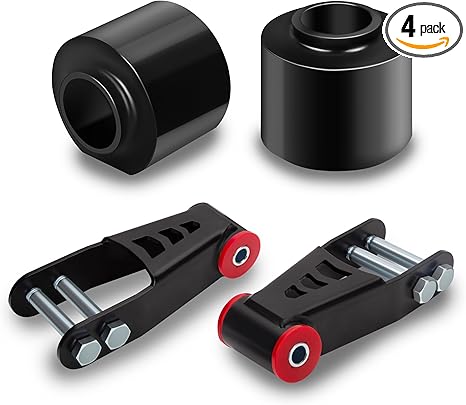
Product Overview: The KSP Performance 2-Inch Suspension Lift Kit is perfect for budget-conscious enthusiasts who want a slight boost in height without breaking the bank. This kit includes coil spacers and rear add-a-leafs.
Components:
- Front coil spacers
- Rear add-a-leafs
- Hardware for installation
Installation Time and Difficulty:
- Time: 3-4 hours
- Difficulty: Easy to moderate
- Tools Needed: Basic hand tools, spring compressors
Price Budget: At approximately $100, this kit is an affordable option for entry-level modifications.
Quality: Customers praise the durability of the spacers and the noticeable improvement in stance. However, some report a firmer ride due to the add-a-leafs.
3 Inch Jeep Cherokee Lift Kits
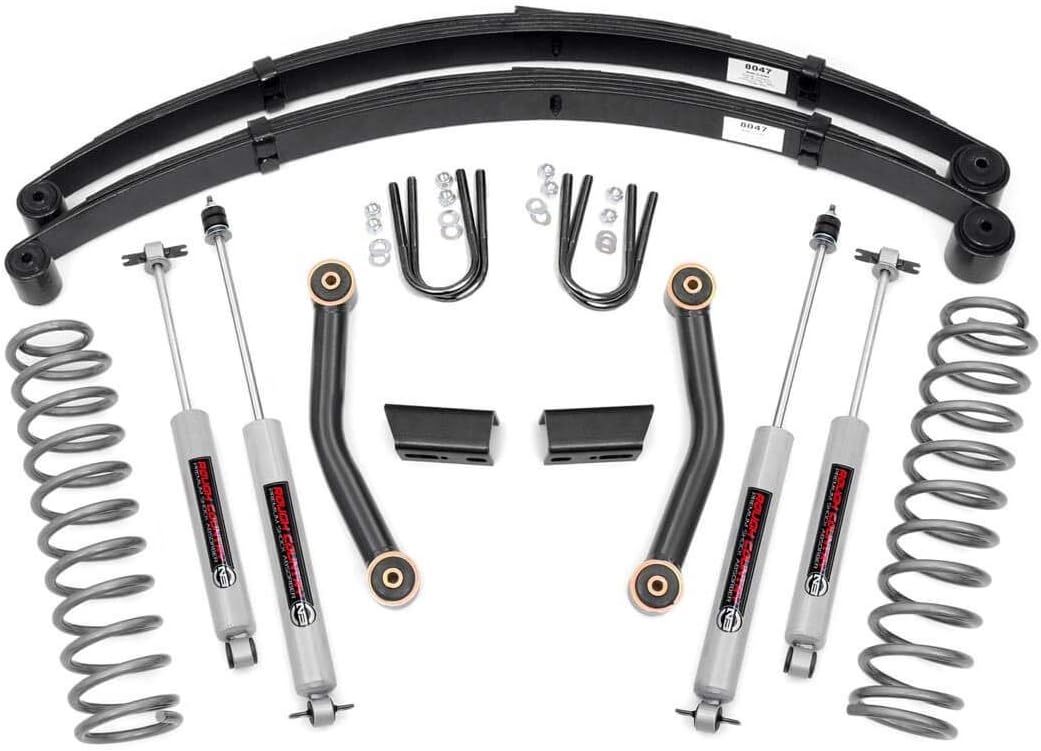
Product Overview: Rough Country’s 3-Inch Lift Kit offers a great balance between cost and capability. Ideal for weekend warriors who want to tackle moderate trails.
Components:
- Front coil springs
- Rear add-a-leafs and shocks
- Sway bar drop brackets
- Track bar bracket
Installation Time and Difficulty:
- Time: 5-6 hours
- Difficulty: Moderate
- Tools Needed: Wrenches, sockets, floor jack, jack stands
Price Budget: Priced at $300, this kit is a step up in performance and quality.
Quality: Users report smoother off-road rides and improved articulation. However, installation instructions could be clearer.
4.5 Inch Jeep Cherokee Lift Kits
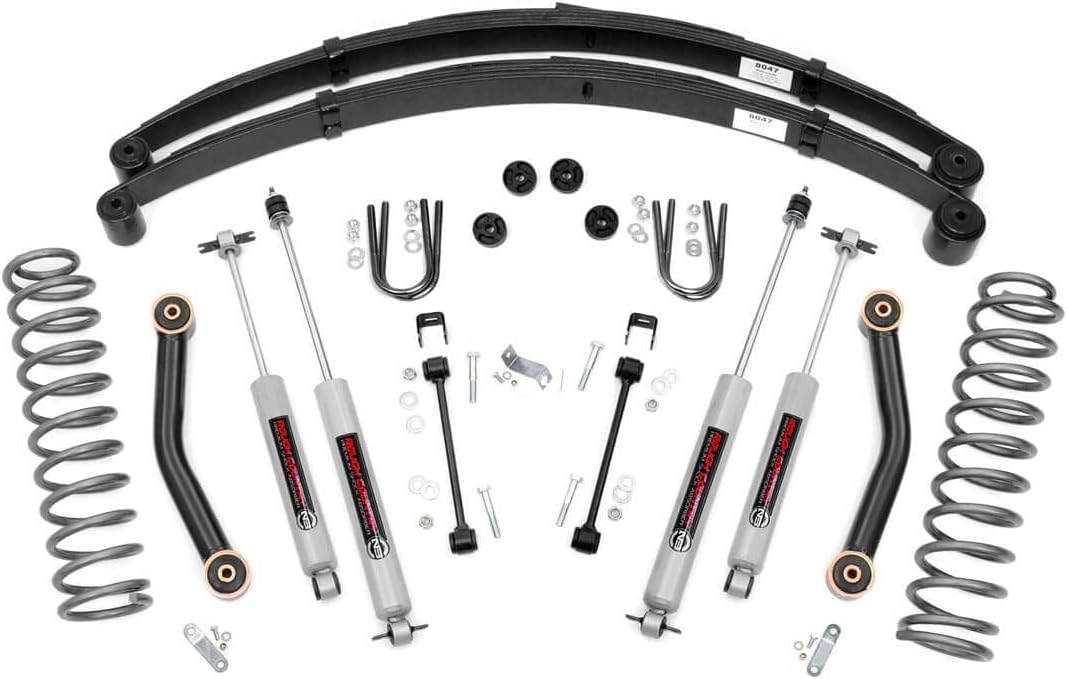
Product Overview: This Rough Country 4.5-Inch Suspension Lift Kit is designed for serious off-roaders who want superior ground clearance and articulation.
Components:
- Front coil springs
- Rear leaf springs
- Control arms
- Shocks
- Drop brackets
Installation Time and Difficulty:
- Time: 8-10 hours
- Difficulty: Hard
- Tools Needed: Advanced tools, spring compressor, torque wrench
Price Budget: At $600, this kit offers exceptional value for its height and performance.
Quality: Users rave about the rugged construction and improved handling. Be prepared for a stiffer ride, especially on-road.
4.5 Inch Jeep Cherokee Lift Kits
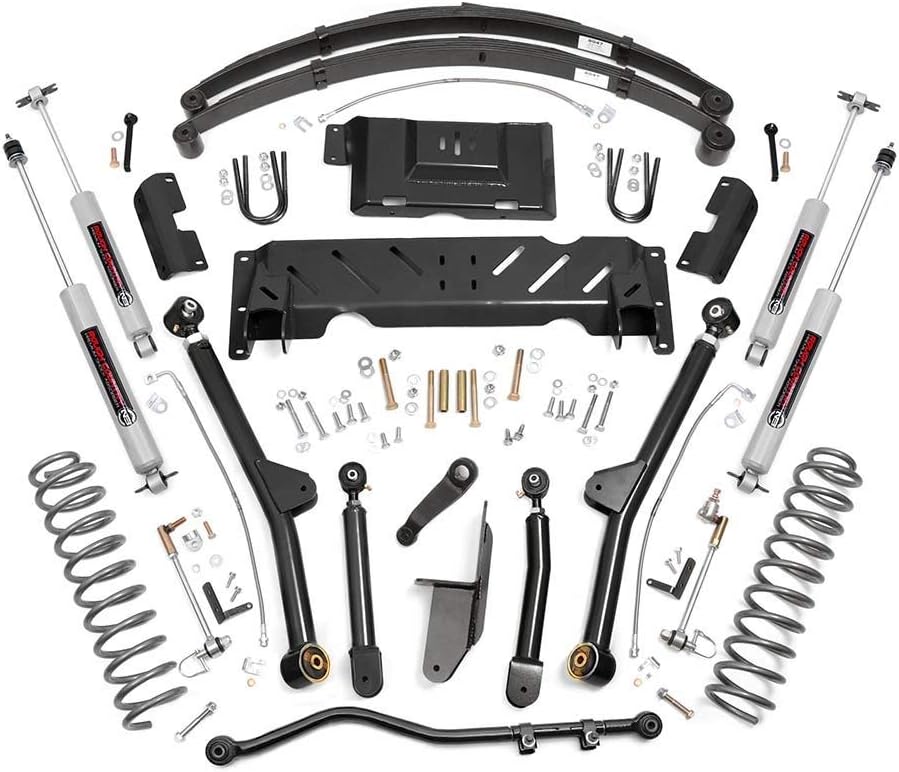
Product Overview: An upgrade from the basic 4.5-inch Suspension Lift Kit, this version includes long arms for better suspension geometry.
Components:
- Long-arm control arms
- Front coil springs
- Rear leaf springs
- Extended shocks
Installation Time and Difficulty:
- Time: 10-12 hours
- Difficulty: Very hard
- Tools Needed: Drill, grinder, specialty tools for long-arm brackets
Price Budget: Expect to pay around $1,000 for this premium setup.
Quality: This kit is praised for its ability to smooth out harsh terrain. Long arms significantly improve ride quality and axle articulation.
6.5 Inch Jeep Cherokee XJ Lift Kits with Long Arms
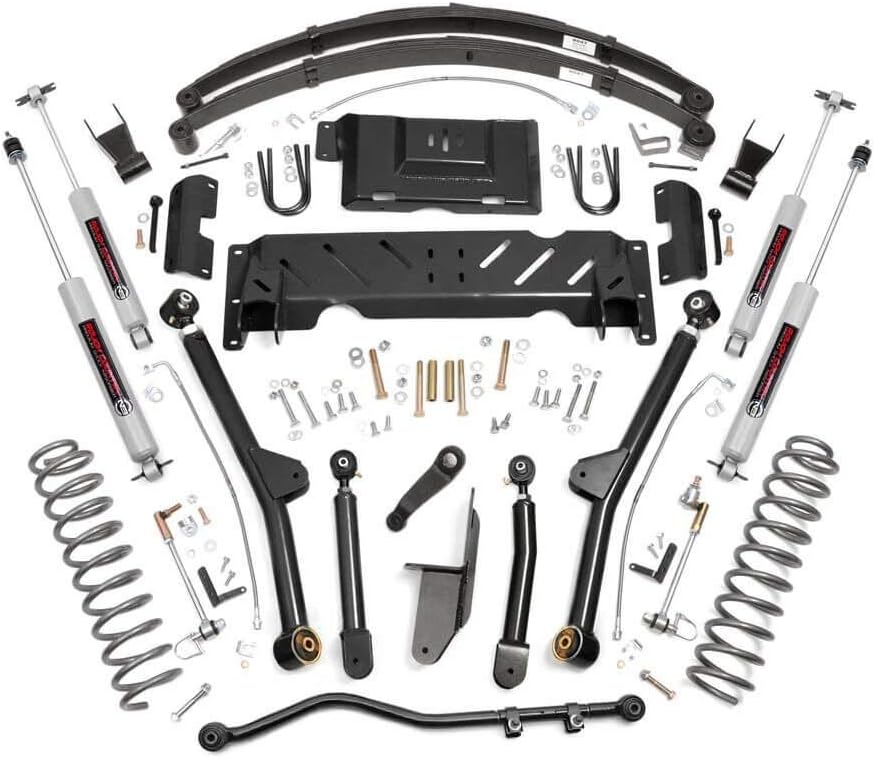
Product Overview: For those who want to go big or go home, Rough Country’s 6.5-Inch Suspension Lift Kit is the ultimate choice.
Components:
- Long-arm control arms
- Heavy-duty track bar
- Extended brake lines
- Front and rear coil springs
- Adjustable shocks
Installation Time and Difficulty:
- Time: 12-16 hours
- Difficulty: Expert
- Tools Needed: Welding tools, professional-grade equipment
Price Budget: At $1,500, this kit is a significant investment but delivers unmatched performance.
Quality: Off-road enthusiasts love the unbeatable clearance and articulation. However, this kit is overkill for daily drivers.
Long Arm Lift Kit: Transforming Your XJ Cherokee Suspension
A Long Arm Lift Kit is a specialized upgrade for the XJ Cherokee Suspension, designed to improve handling, performance, and overall ride quality, especially for vehicles with a Suspension Lift Kit of 4 inches or more. By addressing the challenges that come with lifting your Jeep, this kit helps you achieve the best ride quality for both daily driving and off-road adventures.
What is a Long Arm Lift Kit?
A Long Arm Lift Kit extends the length of the control arms, repositioning their mounting points to a lower angle. This adjustment minimizes the stress and strain caused by steep control arm angles on lifted vehicles. For XJ Cherokee owners using a Suspension Lift Kit, a Long Arm Lift Kit ensures smoother articulation and better suspension geometry.
How is a Long Arm Lift Kit Installed?
The installation involves:
- Replacing stock control arms with longer, sturdier arms.
- Adding brackets or cross-members to relocate the mounting points lower on the frame.
- Fine-tuning the setup to ensure compatibility with the XJ Cherokee Suspension system.
This process improves how the suspension components interact, ensuring the best ride quality without compromising durability. Professional installation is often recommended due to the precise adjustments required.
How Does It Affect Geometry?
When you install a Suspension Lift Kit, the geometry of your XJ Cherokee Suspension changes—steepening control arm angles, reducing caster, and increasing drivetrain stress. A Long Arm Lift Kit corrects these issues by:
- Flattening the control arm angles, reducing harshness and improving handling during daily driving.
- Restoring caster angles for better steering stability, particularly at higher speeds.
- Reducing wear and tear on suspension components by optimizing alignment and movement.
Think of it as giving your Jeep a better “suspension handshake”—everything works together in harmony, whether you’re navigating the trails or heading to the grocery store.
Why Choose a Long Arm Lift Kit?
If you want the best ride quality from your Suspension Lift Kit, especially for daily driving, a Long Arm Lift Kit is essential. It ensures your XJ Cherokee Suspension operates efficiently, providing stability, comfort, and longevity. Whether you’re tackling rocky terrain or cruising the highway, this upgrade enhances both performance and safety.
By correcting the geometry and minimizing suspension strain, a Long Arm Lift Kit turns your lifted XJ Cherokee into a confident and capable machine, ready for any adventure.
What Tires Fit Each Suspension Lift on the Jeep Cherokee XJ?
Understanding the right tire size for your lift kit is key to avoiding unnecessary modifications and ensuring your Jeep Cherokee XJ performs at its best. Here’s a quick breakdown of tire sizes and suspension lift compatibility:
31-Inch Tires with Stock Suspension
- Is It Feasible? Possible with some adjustments.
- Challenges: Expect tire rubbing during turns or suspension compression, especially off-road. Fender trimming or bump stops may be needed.
- Recommendation: Stick with a slightly smaller size, like 30-inch tires, for better clearance and hassle-free driving.
33-Inch Tires with a 2-Inch Lift
- Is It Feasible? Technically, yes, but not practical without heavy modifications.
- Challenges: Significant fender trimming (cutting the “guardabarros”) is required, and aggressive off-roading will still lead to rubbing.
- Recommendation: Upgrade to at least a 4-inch lift for a smoother fit and improved performance.
35-Inch Tires with a 4.5-Inch Lift
- Is It Feasible? Yes, with proper setup.
- Challenges: Fender trimming is almost mandatory, and axles should be reinforced to handle the additional stress. Steering upgrades and extended brake lines may also be needed.
- Recommendation: This setup works well for off-road enthusiasts seeking a balance between capability and reasonable modifications.
37-Inch Tires with a 6.5-Inch Lift
- Is It Feasible? Absolutely, but only with major upgrades.
- Challenges: Extensive fender trimming and heavy-duty axle reinforcements are required. A slip yoke eliminator (SYE) and custom driveshaft are mandatory for proper drivetrain function.
- Recommendation: This configuration is best for extreme off-road builds where performance outweighs convenience.
Matching the right tire size to your lift kit is all about balancing performance and practicality. Pushing tire sizes beyond the recommended limits for your suspension can lead to issues like tire rubbing, compromised handling, and additional strain on your drivetrain. Choose wisely to make your XJ both trail-ready and road-friendly!
In summary, while fitting 33-inch tires on a 2-inch lift is achievable with extensive modifications, it’s generally more practical and less labor-intensive to opt for a higher lift kit when aiming for larger tire sizes.
Note: Always consider the impact of larger tires on your vehicle’s drivetrain, fuel efficiency, and handling. It’s advisable to consult with a professional or experienced off-road specialist to ensure compatibility and safety when making modifications to your Jeep Cherokee XJ.
What are the Key Differences Between Them?
The primary differences among these lift kits lie in their height, complexity, and components. While a 2-inch lift is ideal for minor trails, the 6.5-inch kit is built for extreme off-roading. Long-arm kits provide better geometry but require advanced tools and skills to install.
Comparing Jeep Cherokee XJ Lift Kits
| Lift Height | Components | Ideal Use Case | Price Range | Tire Size Compatibility |
|---|---|---|---|---|
| 2 Inch | Coil spacers, add-a-leafs | Budget-friendly, mild off-roading | $50-100 | Up to 31 inches |
| 3 Inch | Coil springs, shocks, sway bar brackets | Moderate trails | $300-500 | 31-32 inches |
| 4.5 Inch | Leaf springs, shocks, drop brackets | Serious off-roading | $600-900 | 32-33 inches |
| 4.5 Inch LA | Long arms, advanced suspension parts | Advanced off-roading | $1,000-1500 | 33-35 inches |
| 6.5 Inch LA | Long arms, heavy-duty components | Extreme off-roading | $1,500-2000 | 35-37 inches |
Shocks upgrade recommendation:
Fox 2.0 Shocks with Reservoir
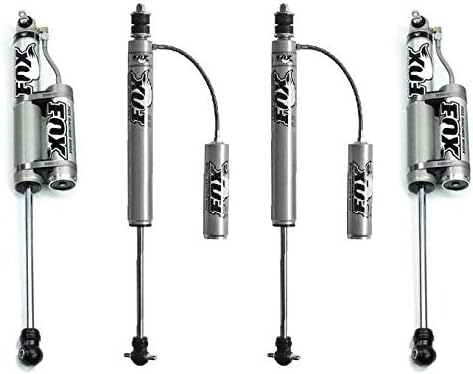
If your budget allows, I highly recommend upgrading your shock absorbers to the Fox 2.0 Performance Series with Reservoir. These shocks are designed to handle extreme off-road conditions while providing an incredibly smooth ride on-road.
Product Details:
- External reservoir for increased oil and nitrogen capacity
- Aluminum body for better heat dissipation
- Custom-tuned for the Jeep XJ
Benefits:
- Enhanced suspension performance
- Reduced heat buildup during prolonged use
- Improved handling and stability
Price: Priced around $450 for a pair, these shocks are a premium addition to any lift kit setup.
Customer Feedback: Users love the noticeable improvement in ride quality and durability. Many highlight that these shocks significantly reduce bumpiness and increase control, especially on rugged trails.
FAQs for Jeep Cherokee XJ and Lift Kits
What is the best lift kit for a Jeep Cherokee XJ?
The best lift kit for a Jeep Cherokee XJ depends on your needs, such as on-road comfort, off-road performance, and budget. Popular choices include the Rough Country 3-inch Lift Kit, known for its affordability and quality, or the Express 4.5-inch Lift Kit, which offers excellent off-road articulation and durability.
How much lift do I need for 33-inch tires on a Jeep Cherokee XJ?
You typically need a lift of 4.5 to 6 inches to fit 33-inch tires on a Jeep Cherokee XJ. This range accommodates suspension clearance and articulation for off-road conditions.
What tools are required to install a lift kit on a Jeep Cherokee XJ?
Common tools include:
- Jack stands and a floor jack
- Socket set and wrenches
- Torque wrench
- Spring compressors
- Hammer and pry bar
- Optional: A professional alignment tool after installation.
How does lifting my Jeep Cherokee XJ affect its performance?
Lifting your Jeep Cherokee XJ improves ground clearance and enhances off-road capability. However, it may affect the center of gravity, causing potential stability changes on highways, and may require extended brake lines or adjustments to the drive shaft.
Do I need a slip yoke eliminator (SYE) with a lift kit?
For lifts above 3 inches, installing an SYE and a new driveshaft is recommended to avoid vibrations caused by steep driveshaft angles.
Can I lift my Jeep Cherokee XJ at home?
Yes, if you have basic mechanical skills and the required tools, you can lift your Jeep Cherokee XJ at home. However, professional installation ensures safety and proper setup.
What are the maintenance requirements for a lifted Jeep Cherokee XJ?
Regularly check and maintain:
- Suspension components for wear
- Driveshaft and U-joints for vibrations
- Wheel alignment and tire balance
- Torque on suspension bolts.
Does a lift kit void my Jeep Cherokee XJ warranty?
Lift kits may void parts of your vehicle’s warranty related to suspension and drivetrain. Consult your warranty provider for specifics.
Are lift kits legal for on-road use?
Lift kits are generally legal, but some jurisdictions have height restrictions and safety requirements. Ensure compliance with local laws and install modifications like bump stops or extended brake lines as needed.
What are the different types of lift kits for Jeep Cherokee XJs?
Extreme Kits (5+ inches): Best for serious off-road use, typically requiring driveline adjustments.
Budget Boosts (1-2 inches): Spacer or shackle-based kits, great for minor clearance increases.
Mid-Range Kits (3-4.5 inches): Include new coils, leaf springs, and shocks for balanced performance.
Final thoughts on lifting the XJ
Upgrading your Jeep XJ with a lift kit is an exciting step that transforms your vehicle into a more capable and versatile machine. Whether you’re exploring Jeep Cherokee forums for advice or consulting the forum community for tips on different lift kits, you’ll find a wealth of knowledge from experienced Jeep owners who have walked this path before.
Choosing the right lift kit depends on your needs and goals. Taller tires for off-road adventures? Better ground clearance for rugged trails? Or maybe you’re simply looking for new products to enhance your daily driving experience. Remember, while some kits may lead to a rough ride without proper adjustments, investing in quality components ensures your XJ maintains stability and comfort.
When shopping for a lift kit, look for great prices, free shipping options, and excellent customer service from trusted retailers. These details make a big difference in your overall satisfaction. Joining a forum community can also help you compare experiences, find deals, and learn installation tips.
Lifting your Jeep Cherokee XJ isn’t just about aesthetics—it’s about unlocking its full potential. Take your time, research different lift kits, and turn your XJ into the ultimate adventure machine!
You should also check the following articles
